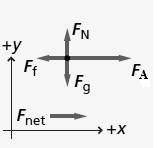
Concept explainers
The coefficient of kinetic friction between the two given surfaces.
Answer to Problem 23PP
The coefficient of kinetic friction between the given surfaces is
Explanation of Solution
Given:
A bookcase of mass 41-kg is to be moved from one point to another and a force of 65 N is applied in the horizontal direction causing an acceleration 0.12 m/s2 .
Formula Used:
Here, a force is applied horizontally on the bookcase to move it along the carpet . The entire distribution of forces on the bookcase in shown in Figure 1.

Figure 1
There will be a force opposing the applied force which is due to kinetic friction in this case since the body is in motion. Here, the body is in acceleration and hence there will be a net force in horizontal direction given by,
The net force is given by
Now, the kinetic friction force will be proportional to the normal force acting in the body. In this case, the normal force is equal to the weight of the body as there are no other forces along the normal.
Thus, the kinetic friction force can be expressed as,
Here
Based on this, the magnitude of horizontal force to be applied can be deduced as,
And, the coefficient of kinetic friction can be calculated as,
Calculation:
Given the mass of bookcase as 41-kg, and horizontal force as 65 N.
Now, by substituting the acceleration due to gravity and given parameters, the coefficient of kinetic friction can be calculated based on (5) as
Conclusion:
Thus, the coefficient of kinetic friction between the given surfaces is 0.1495.
Chapter 5 Solutions
Glencoe Physics: Principles and Problems, Student Edition
Additional Science Textbook Solutions
Introductory Chemistry (6th Edition)
Campbell Biology: Concepts & Connections (9th Edition)
Anatomy & Physiology (6th Edition)
Chemistry: The Central Science (14th Edition)
Campbell Biology (11th Edition)
Organic Chemistry (8th Edition)
- A pendulum has a 0.4-m-long cord and is given a tangential velocity of 0.2 m/s toward the vertical from a position 0 = 0.3 rad. Part A Determine the equation which describes the angular motion. Express your answer in terms of the variable t. Express coefficients in radians to three significant figures. ΜΕ ΑΣΦ vec (t)=0.3 cos (4.95t) + 0.101 sin (4.95t) Submit Previous Answers Request Answer × Incorrect; Try Again; 6 attempts remainingarrow_forwardPart A ■Review The uniform 150-lb stone (rectangular block) is being turned over on its side by pulling the vertical cable slowly upward until the stone begins to tip. (Figure 1) If it then falls freely (T = 0) from an essentially balanced at-rest position, determine the speed at which the corner A strikes the pad at B. The stone does not slip at its corner C as it falls. Suppose that height of the stone is L = 1.2 ft. Express your answer to three significant figures and include the appropriate units. ? ft VA 10.76 S Submit Previous Answers Request Answer × Incorrect; Try Again; 6 attempts remainingarrow_forwardConsider the circuit shown in the figure. The battery has emf ε = 69 volts and negligible internal resistance. The inductance is L = 0.4 H and the resistances are R 1 = 12 Ω and R 2 = 9.0 Ω. Initially the switch S is open and no currents flow. Then the switch is closed. After leaving the switch closed for a very long time, it is opened again. Just after it is opened, what is the current in R 1?arrow_forward
- A capacitor with a capacitance of C = 5.95×10−5 F is charged by connecting it to a 12.5 −V battery. The capacitor is then disconnected from the battery and connected across an inductor with an inductance of L = 1.55 H . At the time 2.35×10−2 s after the connection to the inductor is made, what is the current in the inductor? At that time, how much electrical energy is stored in the inductor?arrow_forwardCan someone help me with this question. Thanks.arrow_forwardCan someone help me with this question. Thanks.arrow_forward
 College PhysicsPhysicsISBN:9781305952300Author:Raymond A. Serway, Chris VuillePublisher:Cengage Learning
College PhysicsPhysicsISBN:9781305952300Author:Raymond A. Serway, Chris VuillePublisher:Cengage Learning University Physics (14th Edition)PhysicsISBN:9780133969290Author:Hugh D. Young, Roger A. FreedmanPublisher:PEARSON
University Physics (14th Edition)PhysicsISBN:9780133969290Author:Hugh D. Young, Roger A. FreedmanPublisher:PEARSON Introduction To Quantum MechanicsPhysicsISBN:9781107189638Author:Griffiths, David J., Schroeter, Darrell F.Publisher:Cambridge University Press
Introduction To Quantum MechanicsPhysicsISBN:9781107189638Author:Griffiths, David J., Schroeter, Darrell F.Publisher:Cambridge University Press Physics for Scientists and EngineersPhysicsISBN:9781337553278Author:Raymond A. Serway, John W. JewettPublisher:Cengage Learning
Physics for Scientists and EngineersPhysicsISBN:9781337553278Author:Raymond A. Serway, John W. JewettPublisher:Cengage Learning Lecture- Tutorials for Introductory AstronomyPhysicsISBN:9780321820464Author:Edward E. Prather, Tim P. Slater, Jeff P. Adams, Gina BrissendenPublisher:Addison-Wesley
Lecture- Tutorials for Introductory AstronomyPhysicsISBN:9780321820464Author:Edward E. Prather, Tim P. Slater, Jeff P. Adams, Gina BrissendenPublisher:Addison-Wesley College Physics: A Strategic Approach (4th Editio...PhysicsISBN:9780134609034Author:Randall D. Knight (Professor Emeritus), Brian Jones, Stuart FieldPublisher:PEARSON
College Physics: A Strategic Approach (4th Editio...PhysicsISBN:9780134609034Author:Randall D. Knight (Professor Emeritus), Brian Jones, Stuart FieldPublisher:PEARSON





